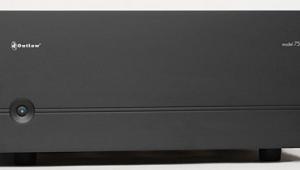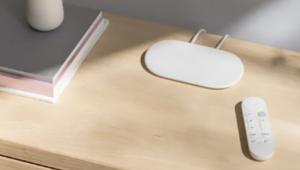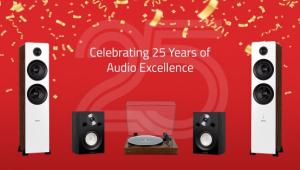Beyond my budget (I use Onkyo in my home theater) but I would if I could. I recall listening to Krell amps drive Martin Logan stats back in the late 80s glory days of the small high end stereo shops, pure bliss (to my then much younger and better ears) I wish them all the luck in the world, and I also wish the Ma and Pa small electronic stores would come back. I used to buy my gear in those places because the service and knowledge base was the best, now there is little choices left..go to BB or shop Amazon in my pajamas and hope for the best. So much has changed in this hobby. Oh, prices are better, but the experience has greatly declined.
Krell Theater 7 Amplifier Review

AT A GLANCE
Plus
Class-A sound with improved efficiency
Exceptional transparency and control
Minus
Not the most powerful amp on the block
Display unnecessary for most users
THE VERDICT
Krell returns to form with an exceptionally capable amplifier for well-heeled home theaters where quality takes precedence over quantity.
It's hard to overstate the importance of Krell Industries in the history of high-end audio. Founded by Dan and Rondi D'Agostino in 1980, Krell was the audio equivalent of Lamborghini—an audacious riposte to more Ferrari-like rivals such as Mark Levinson and Audio Research. For almost three decades, Krell went from strength to strength, introducing a stream of ever more ambitious products that tested the depth of their customers' pockets, along with the strength of their audio equipment shelving. Then, starting around a decade ago, the brand slowly slipped off the radar screens of most audiophiles.
We now know that the D'Agostinos were the target of what Dan has described as a hostile take- over by a group of investors. The new owners were more interested in making a deal to put Krell-branded high-end sound systems in Acura cars than in pursuing the comparatively small home audio market. Before long, some products were being manufactured in China, and Krell's edge slipped away.
While Dan moved on with a new venture, Rondi stayed and fought for the company she had co-founded 30 years earlier, eventually succeeding in regaining control. Krell is now working to reestablish its brand as a world leader in a somewhat smaller, yet even more competitive, high-end audio market. The Theater 7 amplifier is part of that process.
Krell amplifiers have always been overstated in design and understated in their on-paper specifications. Back in the 1980s, we would talk about “Krell watts,” where the amp's massive power supply and conservative on-paper power rating meant that it could drive speakers in real world systems way beyond what the numbers would suggest. With 7 x 105 watts, all channels driven into 8 ohms, the Theater 7 may not sound like a powerhouse, but with most speakers it can really deliver the goods.
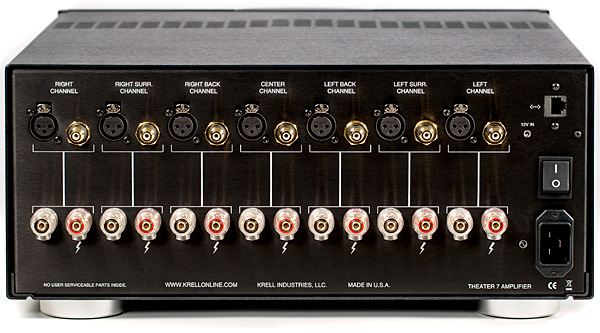
Krell built its reputation on amps that deliver pure class-A power, free from the switching distortion common to more typical class-A/B designs. The problem is that pure class-A amps are notoriously inefficient and pump out huge quantities of heat. Instead of having to make a choice between ultimate sound quality and efficiency, Krell developed what they call iBias Class A to give you both at the same time. While sliding bias amps are nothing new, the difference with iBias is that the bias level is determined by what's happening at the amp's output where the speaker load is connected, rather than at the input.
Setup
Despite being the smallest and most affordable multichannel amplifier in Krell's lineup, the Theater 7 ($8,250) is still a beast by any normal standards. Weighing in at 70 pounds and measuring over 20 inches deep, you're going to need a pretty stout shelf to support it. A bottom-mounted cooling fan ensures that things never get too hot, but Krell still advises that you give the amp plenty of breathing room.
As with any power amp, hookup is straightforward. Each of the seven channels has both balanced XLR and single-ended RCA inputs, but rather than putting a switch in the signal path to select between them, Krell includes seven little copper loops that short the inverted phase of the XLR input to ground when it's not being used. Krell describes the speaker terminals as five-way binding posts, but I found they weren't particularly well-suited to larger spade terminals, working best with either bare wire or banana plugs. The power inlet uses a hefty 20-amp capable C20 IEC plug rather than the more common 15-amp C14 variety, although the supplied power cable has a standard 15-amp plug at the wall outlet end for compatibility. Rounding out the connections are a 12-volt trigger input and a LAN port.
While the Theater 7 doesn't have its own control app, it can be addressed remotely via the hardwired LAN connection. When you switch on the amp, the front panel display shows an IP address, and when you enter that IP address on a portable device or computer that's on the same network, a control screen pops up. From there you can update the firmware, switch the amp on or off, adjust the no-signal switch-off timer, monitor the operating temperature and fan status, and carry out other operations. However, this functionality is meant more for a custom installation professional or Krell technical support to diagnose problems remotely than it is for user operation.
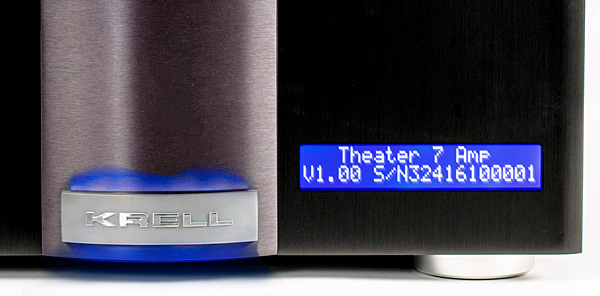
I primarily used the Theater 7 to drive my PSB Synchrony seven-channel surround speaker rig, but rather than using them with my subwoofer as I would normally do, I simply ran the Synchrony One towers full-range and switched off the sub. This allowed me to evaluate the amp's full-range performance without siphoning off the deep bass frequencies to a separately powered unit.
Performance
Starting with two-channel music streamed from Qobuz, I fired up some of my favorite evaluation tracks. It immediately became clear that despite its name, the Theater 7 isn't just for movies. Drumming legend Steve Jordan is famous for the crisp snap that he gets from his snare, and on the reggae track “Words of Wonder” from Keith Richards' Main Offender album the impact and dynamics of his stick work was certainly ear-opening. Charley Drayton's bass on this track is a great test of an amp's ability to control a speaker. With the Theater 7, his bass lines were full-bodied and powerful, yet also tuneful and easy to follow.
Any home theater amp should be expected to deliver sledgehammer dynamics and an ability to maintain an iron grip on the speaker drivers, but it can be a taller order to combine that with subtlety and transparency. The track “Ramblin' Boy” from The Weavers' Reunion At Carnegie Hall is a tough test of those properties. When I listened to it with the Theater 7, the purity of Pete Seeger's voice, and the huge sense of natural spaciousness when the crowd joined him in singing, provided an impressive demonstration of the benefits of the Krell's iBias Class A circuitry.
While Incredibles 2 didn't have quite the spark that made the original movie so great, there's no denying that the opening nine-minute sequence when The Underminer robs a bank in Metroville is a fantastic home theater demonstration. With the combined sounds of the Underminer's tunneling machine and money vacuum, the Incredibles' attempts to stop him, and a jazzy music background all going at once, this sequence can give any audio system a real workout. The Theater 7 maintained its composure throughout the clip, with dialogue remaining clear and fully resolved. Even without benefit of a subwoofer, the combination of the Krell amp and the Synchrony One tower speakers managed to get the walls shaking in my 14 x 16-foot theater room.
After taking into consideration “Krell watts” versus what you get with more typical power amps, 105 watts-per-channel can still be a limiting factor in some larger rooms, especially when inefficient speakers are used. Personally, I'm more of a quality over quantity kind of guy, and I'd always go for an amp like the Theater 7 over a lesser alternative with a higher power output specification. In my setup, I never felt like I was running short of juice. (Of course, if you want to have it all, Krell also offers the 7 x 200-watt Chorus 7200XD amplifier.)
Conclusion
After a few years spent flying under the radar, Krell is very much back in business. While the company's main focus has always been two-channel audio, the Theater 7 shows that it's also a serious player in the multichannel game. For a home theater where the main focus is quality rather than trying to blow out everyone's ears, it's hard to beat Krell's Theater 7 amplifier.
- Log in or register to post comments


I always loved Krell and they were one of the kings of underating amplifiers. I find it funny how the minuses section says "Not the most powerful amp on the block", because if it was tested it probably puts out over 200WPC. I know, I know, I have to go to stereophile for actual tests now...

Your reviewing an amp that is well beyond the means of the average household and your readership. Why? Is this the 'people like to look at pictures of Ferraris' argument that the reviewer class loves to trot out? You could have reviewed similar amps from companies like Outlaw, Emotiva, Marantz, etc. but you wasted page count on this? Even though your rag doesn't cost very much, I'm going to think about whether I want to spend another dime on it when my subscription expires. I can read most of it online for nothing anyway and I do not see why I should reward bad editorial decision making on review products. Do better.
















